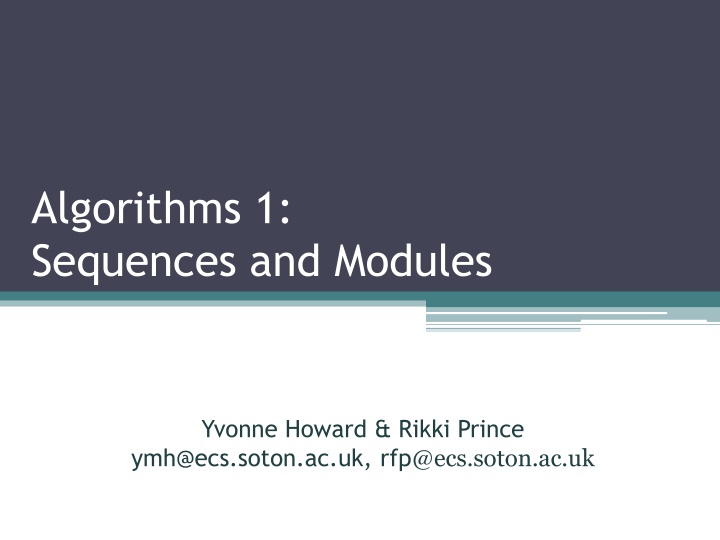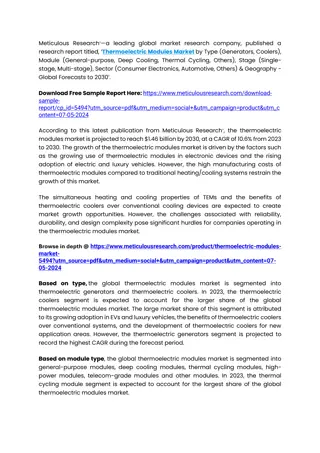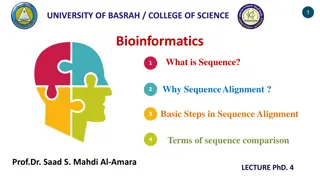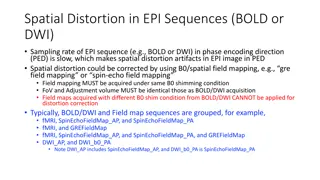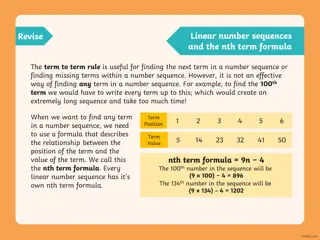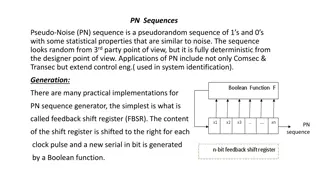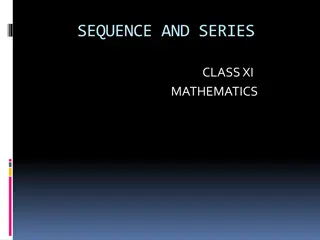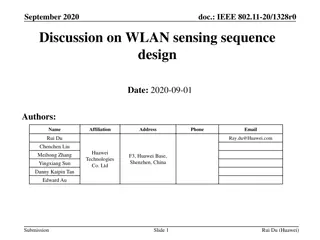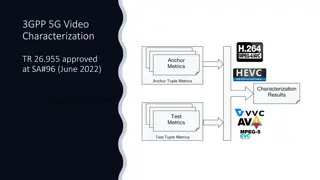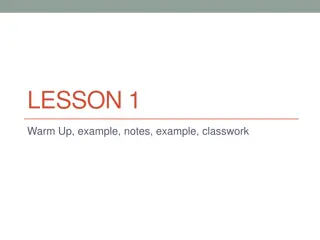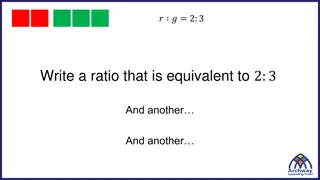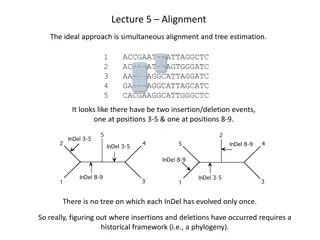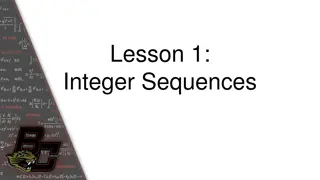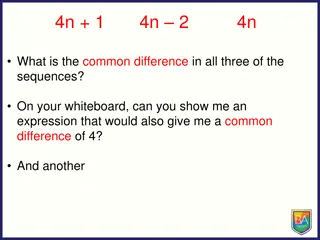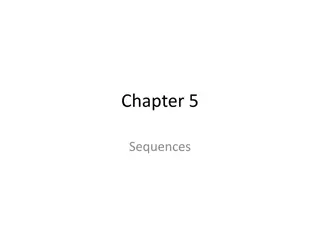Sequences and Modules
Dive into the world of algorithms with a focus on sequences and modules through the insightful work by Yvonne Howard and Rikki Princeymh. Explore the intricacies of algorithm design, implementation, and analysis in this comprehensive guide. Gain a deeper understanding of how algorithms operate and impact various aspects of computing. The content delves into the core principles and techniques essential for mastering algorithms effectively.
Download Presentation

Please find below an Image/Link to download the presentation.
The content on the website is provided AS IS for your information and personal use only. It may not be sold, licensed, or shared on other websites without obtaining consent from the author.If you encounter any issues during the download, it is possible that the publisher has removed the file from their server.
You are allowed to download the files provided on this website for personal or commercial use, subject to the condition that they are used lawfully. All files are the property of their respective owners.
The content on the website is provided AS IS for your information and personal use only. It may not be sold, licensed, or shared on other websites without obtaining consent from the author.
E N D
Presentation Transcript
Algorithms 1: Sequences and Modules Yvonne Howard & Rikki Prince ymh@ecs.soton.ac.uk, rfp@ecs.soton.ac.uk
Overview Algorithms Pseudocode What are Modules? Next time More refinement good modularisation Variables Parameters
Definitions - Etymology Algorism (n) Arab mathematician Abu Abdullah Muhammad ibn Musa al-Khwarizmi (early 9th century) Europe became aware of his work on Algebra Arab numerals became associated with his name Has since evolved to mean all processes for solving tasks
Definitions - Dictionary Algorithm (n) An algorithm is a sequence of finite instructions, often used for calculation and data processing Wikipedia "A step-by-step problem-solving procedure, especially an established, recursive computational procedure for solving a problem in a finite number of steps. Answers.com A step-by-step procedure for solving a problem or accomplishing some end especially by a computer Merriam Webster Dictionary
Definitions - Dictionary Algorithm (n) An algorithm is a sequence of finite instructions, often used for calculation and data processing Wikipedia "A step-by-step problem-solving procedure, especially an established, recursive computational procedure for solving a problem in a finite number of steps. Answers.com A step-by-step procedure for solving a problem or accomplishing some end especially by a computer Merriam Webster Dictionary
Definitions - Dictionary Algorithm (n) An algorithm is a sequence of finite instructions, often used for calculation and data processing Wikipedia "A step-by-step problem-solving procedure, especially an established, recursive computational procedure for solving a problem in a finite number of steps. Answers.com A step-by-step procedure for solving a problem or accomplishing some end especially by a computer Merriam Webster Dictionary
Definitions - Dictionary Algorithm (n) An algorithm is a sequence of finite instructions, often used for calculation and data processing Wikipedia "A step-by-step problem-solving procedure, especially an established, recursive computational procedure for solving a problem in a finite number of steps. Answers.com A step-by-step procedure for solving a problem or accomplishing some end especially by a computer Merriam Webster Dictionary
Pseudocode Pseudocode is a compact and informal high-level description of a computer programming algorithm that uses the structural conventions of some programming language, but is intended for human reading rather than machine reading - Wikipedia A notation resembling a simplified programming language, used in program design; esp. one consisting of expressions in natural language syntactically structured like a programming language - Oxford English Dictionary
Pseudocode Pseudocode is a compact and informal high-level description of a computer programming algorithm that uses the structural conventions of some programming language, but is intended for human reading rather than machine reading - Wikipedia A notation resembling a simplified programming language, used in program design; esp. one consisting of expressions in natural language syntactically structured like a programming language - Oxford English Dictionary
Pseudocode Pseudocode is a compact and informal high-level description of a computer programming algorithm that uses the structural conventions of some programming language, but is intended for human reading rather than machine reading - Wikipedia A notation resembling a simplified programming language, used in program design; esp. one consisting of expressions in natural language syntactically structured like a programming language - Oxford English Dictionary
Pseudocode Pseudocode is a compact and informal high-level description of a computer programming algorithm that uses the structural conventions of some programming language, but is intended for human reading rather than machine reading - Wikipedia A notation resembling a simplified programming language, used in program design; esp. one consisting of expressions in natural language syntactically structured like a programming language - Oxford English Dictionary
A Problem A caf wants to build an automated system to provide breakfasts. The robot waiter greets people before taking their order by name. Customers can order different combinations of ingredients for their meal, and also ask for one drink. The system then cooks the breakfast. It must be able to fry sausages, bacon, eggs and mushrooms; toast bread, waffles and muffins; and pour their orange juice or coffee. The waiter then serves the breakfast.
Noun Phrase Parsing In order to find the key objects and actions search through the problem definition and extract all the noun phrases Noun phrases are phrases which describe, individuate or pick-out things in the world for example "customer" individuates an entity which will be represented in the system Don't worry about whether or not the noun phrases should be part of the final solution, just meticulously list the noun phrases.
A Problem A caf wants to build an automated system to provide breakfasts. The robot waiter greets people before taking their order by name. Customers can order different combinations of ingredients for their meal, and also ask for one drink. The system then cooks the breakfast. It must be able to fry sausages, bacon, eggs and mushrooms; toast bread, waffles and muffins; and pour their orange juice or coffee. The waiter then serves the breakfast.
A Problem A caf wants to build an automated system to provide breakfasts. The robot waiter greets people before taking their order by name. Customers can order different combinations of ingredients for their meal, and also ask for one drink. The system then cooks the breakfast. It must be able to fry sausages, bacon, eggs and mushrooms; toast bread, waffles and muffins; and pour their orange juice or coffee. The waiter then serves the breakfast.
Verb Phrase Parsing In order to find the common processes, look for verb phrases: those which describe "doing things", for example cooks" is a process which summarises part of the process Don't worry about whether or not the verb phrases describe final processes of the system, or whether or not one subsumes the description of the other, just list them.
A Problem A caf wants to build an automated system to provide breakfasts. The robot waiter greets people before taking their order by name. Customers can order different combinations of ingredients for their meal, and also ask for one drink. The system then cooks the breakfast. It must be able to fry sausages, bacon, eggs and mushrooms; toast bread, waffles and muffins; and pour their orange juice or coffee. The waiter then serves the breakfast.
A Problem A caf wants to build an automated system to provide breakfasts. The robot waiter greets people before taking their order by name. Customers can order different combinations of ingredients for their meal, and also ask for one drink. The system then cooks the breakfast. It must be able to fry sausages, bacon, eggs and mushrooms; toast bread, waffles and muffins; and pour their orange juice or coffee. The waiter then serves the breakfast.
Tidy up the Lists Most often, the requirements will be from a domain of discourse or "mini-world" -- a given requirements specification will be in the language of a particular work practice, such as hospitality. Given this, you can: remove synonyms (noun-phrases which mean the same thing in the domain of discourse). ignore pronouns and articles such as "the", because they refer to an object/noun-phrase in the context of the rest of the sentences.
A Problem A caf wants to build an automated system to provide breakfasts. The robot waiter greets people before taking their order by name. Customers can order different combinations of ingredients for their meal, and also ask for one drink. The system then cooks the breakfast. It must be able to fry sausages, bacon, eggs and mushrooms; toast bread, waffles and muffins; and pour their orange juice or coffee. The waiter then serves the breakfast.
A Problem A caf wants to build an automated system to provide breakfasts. The robot waiter greets people before taking their order by name. Customers can order different combinations of ingredients for their meal, and also ask for one drink. The system then cooks the breakfast. It must be able to fry sausages, bacon, eggs and mushrooms; toast bread, waffles and muffins; and pour their orange juice or coffee. The waiter then serves the breakfast.
Sketch Processes Look for Noun Verb pairs Cook Breakfast Fry Sausage The processes may be described at different levels of detail E.g. Fry Sausage is part of Cook Breakfast Figure out which noun verb pairs are parts of another But Beware! Sometimes there will be a high level phrase (Cook Breakfast) But sometimes there won t be Invent one by grouping together the lower level phrases
What are the Noun Verb Phrases? A caf wants to build an automated system to provide breakfasts. The robot waiter greets people before taking their order by name. Customers can order different combinations of ingredients for their meal, and also ask for one drink. The system then cooks the breakfast. It must be able to fry sausages, bacon, eggs and mushrooms; toast bread, waffles and muffins; and pour their orange juice or coffee. The waiter then serves the breakfast.
Provide Breakfast Greet People Take Order Noun verb pairs Cook Breakfast Fry Egg Fry Sausage Fry Bacon Fry Mushroom Toast Bread Toast Waffle Toast Muffin Pour Juice Pour Coffee Serve Breakfast
This a not an algorithm yet - We need to refine it step by step. This process of understanding a problem is called Stepwise Refinement We take the problem and: decompose (break-down) identify modules elaborate (add an appropriate level of detail) and identify holes The next step is to revise the design (revisiting any of the previous steps as necessary) This will continue until we are happy that we have a working design
? Provide Breakfast Greet People Take Order Cook Breakfast Fry Egg Pseudocode Fry Sausage Fry Bacon Fry Mushroom Assumptions Toast Bread Toast Waffle Toast Muffin Modules Pour Juice Pour Coffee Serve Breakfast
Modules Modules break an algorithm into logical parts Helps with Clarity and Understandability Modules can be reused Within the same algorithm In a different algorithm In Programming Modules can be called: Sub-routines (in older languages) Functions (in procedural languages like C) Methods (in object oriented languages like Java)
Provide Breakfast Provide Breakfast Greet People Take Order ? Cook Breakfast Greet People Take Order Cook Breakfast Serve Breakfast Fry Egg Fry Sausage Fry Bacon Fry Mushroom Toast Bread Toast Waffle Toast Muffin Pour Juice Pour Coffee Serve Breakfast
Provide Breakfast Provide Breakfast Greet People Take Order Cook Breakfast Serve Customer Cook Breakfast ? Serve Breakfast Fry Egg Greet People Take Order Fry Sausage Fry Bacon Fry Mushroom Toast Bread Toast Waffle Toast Muffin Pour Juice Pour Coffee Serve Breakfast
Provide Breakfast Provide Breakfast Greet People Take Order Cook Breakfast Serve Customer Cook Breakfast Serve Breakfast Fry Egg Greet People Take Order Fry Sausage Fry Bacon Fry Mushroom Toast Bread Fry Egg Toast Bread ? Fry Sausage Toast Waffle Toast Waffle Fry Bacon Toast Muffin Toast Muffin Fry Mushroom Pour Juice Pour Coffee Serve Breakfast
Provide Breakfast Provide Breakfast Greet People Take Order Cook Breakfast Serve Customer Cook Breakfast Serve Breakfast ? Fry Egg Greet People Take Order Fry Sausage Fry Bacon Fry Mushroom Toast Bread Fry (X) Toast (X) Bread Waffle Muffin Egg Sausage Bacon Mushroom Toast Waffle Toast Muffin Pour Juice Pour Coffee Serve Breakfast
Provide Breakfast Provide Breakfast Greet People Take Order Cook Breakfast Serve Customer Cook Breakfast Serve Breakfast Fry Egg Greet People Take Order Fry Sausage Fry Bacon Fry Mushroom Toast Bread Fry (X) Toast (X) Toast Waffle ? Pour Juice Toast Muffin Pour Coffee Pour Juice Pour Coffee Serve Breakfast
Provide Breakfast Provide Breakfast Greet People Take Order Cook Breakfast Serve Customer Cook Breakfast Serve Breakfast Fry Egg Greet People Take Order Fry Sausage Fry Bacon Fry Mushroom Toast Bread Fry (X) Toast (X) Make Coffee Toast Waffle Toast Muffin ? Pour Juice Pour Coffee Serve Breakfast Pour (X)
Provide Breakfast Provide Breakfast Greet People Take Order Cook Breakfast Serve Customer Cook Breakfast Serve Breakfast Fry Egg Greet People Take Order Fry Sausage Fry Bacon Fry Mushroom Toast Bread Fry (X) Toast (X) Make Coffee Toast Waffle Toast Muffin Put Food on Plate Pour Juice Give Food to Customer Pour Coffee Serve Breakfast Pour (X)
Writing Sequences is Easy But getting the sequence right is hard Often the specification is inadequate It is easy to make assumptions without realising it Making it complete is challenging Making sure not to miss smaller, less-obvious steps Creating unambiguous instructions Machines are very unforgiving, they do exactly what you ask nothing more, nothing less
: Provide Breakfast Should Cook Breakfast include Make Coffee? Serve Customer Cook Breakfast Serve Breakfast Greet People Take Order Fry (X) Toast (X) Make Coffee Put Food on Plate Give Food to Customer Pour (X)
Provide Breakfast Should Cook Breakfast include Make Coffee? Serve Customer Prepare Breakfast Serve Breakfast Greet People Take Order Cook Breakfast Put Food on Plate Fry (X) Toast (X) Make Coffee Give Food to Customer Pour (X)
Summary From Problem to Solution Algorithm Pseudocode High level description of algorithm intended for human reading but structured like a programming language Noun Verb Parsing Identifying Noun Verb Phrases Looking for Synonyms Identify Holes (Missing Phrases) Modules (subroutines/ functions/ methods) Break down bigger algorithms into chunks Improves Clarity and Reuse Stepwise Refinement
